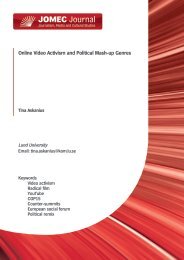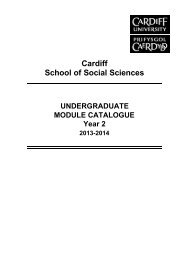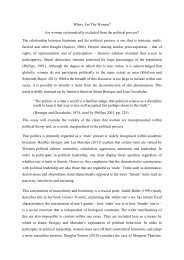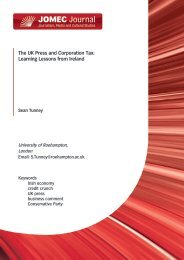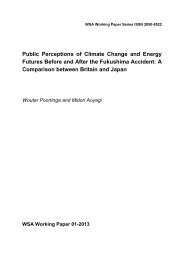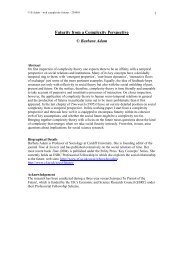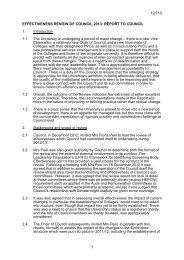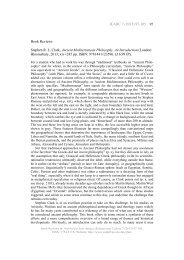APHRODITE IN PROCLUS' THEOLOGY - Cardiff University
APHRODITE IN PROCLUS' THEOLOGY - Cardiff University
APHRODITE IN PROCLUS' THEOLOGY - Cardiff University
Create successful ePaper yourself
Turn your PDF publications into a flip-book with our unique Google optimized e-Paper software.
JLARC 3 (2009) 21-43 39<br />
Proclus’ handling is a masterpiece of allegorical intepretation of myths. First he<br />
states the “materialistic view” on Aphrodite’s name:<br />
In Crat. 183, 4-6.:. Ἀφροδίτην τὴν ἐκ τοῦ ἀφροῦ τὴν γένεσιν ἔχουσαν, καὶ τὸν μὲν<br />
ἀφρὸν εἶναι τὴν τοῦ σπέρματος ἀπόκρισιν, τὴν δ’ ἐκ ταύτης ὑφισταμένην ἐν ταῖς<br />
μίξεσιν ἡδονὴν Ἀφροδίτην εἶναι.<br />
... Aphrodite was born from foam and this foam is the shedding of sperm and pleasure<br />
from ejaculation in intercourses is Aphrodite (translation mine).<br />
Proclus does not simply reject this view, it is valid on its own physical level.<br />
But as the sensible world is the ultimate phase of the self-expression of the divine<br />
powers, behind the physical levels are others and so there is also need for a deeper<br />
interpretation which is to see, “before these extreme and corrupt things, the first<br />
and eternal causes.” Hesiod and divine Orpheus tell the tale of the castration of<br />
Uranus. This violent image expresses “inspired notions” of how the goddess was<br />
causally produced:<br />
In Crat. 183,12-23.: γεννᾶσθαι μὲν οὖν τὴν πρωτίστην Ἀφροδίτην ... ἀπὸ διττῶν<br />
αἰτίων. τοῦ μὲν ὡς δι’ οὗ, τοῦ δὲ ὡς γεννητικοῦ·τὸν μὲν γὰρ Κρόνον αὐτῆς ὡς τὸ<br />
δι’ οὗ τῇ προόδῳ συνεργεῖν, ὡς τὴν γόνιμον δύναμιν τοῦ πατρὸς καλούμενον<br />
καὶ εἰς τοὺς νοεροὺς διακόσμους ἐκδιδόντα, τὸν δ’ Οὐρανὸν ὡς ποιητὴν καὶ αἴτιον,<br />
ἐκ τῆς ἑαυτοῦ γεννητικῆς περιουσίας ἐκφαίνοντα τήνδε τὴν θεόν. καὶ πόθεν γὰρ<br />
ἄλλοθεν ἔδει τὴν συναγωγὸν τῶν διαφερόντων γενῶν κατὰ μίαν ἔφεσιν τοῦ<br />
κάλλους λαβεῖν τὴν ὑπόστασιν ἢ ἐκ τῆς συνοχικῆς τοῦ Οὐρανοῦ δυνάμεως; παράγει<br />
οὖν αὐτὴν ὁ Οὐρανὸς ἐκ τοῦ ἀφροῦ τῶν γονίμων ἑαυτοῦ μορίων ῥιφέντος<br />
εἰς τὴν θάλασσαν<br />
the first Aphrodite was born from two causes: instrumental and generative ones ...<br />
Cronus acts as a coordinated cause in her procession; he calls the fertile power of<br />
his father and mediates it to the noeric levels, and Uranus is the producer and the<br />
cause revealing this goddess starting from his own generative abundance. What<br />
other causes does such a hypostasis need, which unify different kinds, acting on the<br />
basis of the one and same pursuit of beauty, what other if not the gathering power<br />
of Uranus? Thus Uranus generates her from the foam of his fertile organs when<br />
they were thrown down into the sea (translation mine).<br />
The procession of the first Aphrodite is replicated in the lower level of sensible<br />
demiurgy where “the second Aphrodite flows into being from foam in the same<br />
way as the first ...,” as, according to Orphic verses “conquered by great desire the<br />
lofty father (Zeus) threw foam of semen into the sea.”<br />
The two goddesses are different in their causes, order and powers, but their hypostasis<br />
— meaning in this passage innermost nature — is the same. Likewise the<br />
same is the purpose of their action, which is beauty meaning sound proportion and<br />
conformity between any being and its paradigm. The responsibility of the hypercosmic<br />
goddess is to secure compatibility between intelligible and sensible forms<br />
Tuomo Lankila, ‘Aphrodite in Proclus’ Theology,’ in: Journal for Late Antique Religion and<br />
Culture 3 (2009) 21-43; ISSN: 1754-517X; Website: http://www.cardiff.ac.uk/clarc/jlarc




